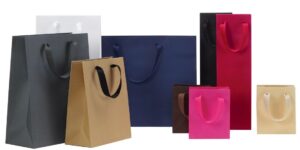All about the Retail bag: Its History, Inventors and Types Today
Brown Retail bags are the norm in our everyday life: we use them to transport groceries at home, carry our department stores’ purchases, and pack our children’s lunches. Retailers make them an empty canvas to create their brand-name packaging. The most imaginative trick-or-treaters dress them up as masks during Halloween. You can easily forget somebody was able to come up with these!
As with all the most significant inventions, the Retail bag could fill an undiscovered need they were missing. Before the Retail bag, bowls, baskets, and other storage containers served as the primary storage solutions in every store and home. Imagine that the invention of a practical, disposable container was a game-changing invention. Businesses could store piles of these bags in their stores. Their affordable price and convenience allowed them to be easily accessible to people with even modest budgets.
How did this seemingly innocuous invention earn an enviable place in the heart (and of the hands) of the average consumer? Looking back on the background and development of the Retail bag may provide some clues.
The Innovators Who gave us the Retail bag
For many centuries, sacks made of canvas, jute, and burlap were the primary method of transporting and holding products across the British Empire. However, the significant advantage of these materials was their durability and strength, and their production was costly and time-consuming. Paper, however, was manufactured at a lower price and quickly became the most popular bag material for travel on trade routes.
Since its invention in the 1800s, the Retail bag has changed thanks to innovative pioneers. The year was 1852 when Francis Wolle invented the first machine to produce mass Retail bags. The Retail bag he created was more like an envelope for mailing than the staple grocery bag that we have to this day (and therefore was only able to carry small items and papers). His invention was the catalyst to the widespread use of paper packaging.
The next major step regarding the style of Retail bags was through Margaret Knight, a prolific inventor who The Columbia Retail bag Company employed. She realized that bags with a square bottom, instead of Wolle’s envelope style, are more practical and effective to use. She designed her Retail bag-making machine inside an industrial shop which opened the way to commercializing bags made of paper. The business model she developed was so successful that she decided to establish her own business that was named which was named the Eastern Retail bag Company. If you take food home at supermarkets, grocery stores or buy a new outfit at the department retailer, you’re reaping the benefits of the work of Knight.
The bags with square bottoms were without a standard feature that makes the bag familiar with and loves pleated sides. We can be grateful to Charles Stillwell for this addition that allowed the bags to fold and consequently be more convenient to keep in storage. A mechanical engineer by profession the design of Charles Stillwell is called the S.O.S. bag, also known as “self-opening sacks.”
But wait! There’s more! In 1918 two St. Paul grocers by the names of Lydia and Walter Deubener came up with an idea to further improve the original idea. By using holes in the sides of the bags made of paper and then affixing a string which also doubled as handles and a bottom reinforcement, the Deubeners realized that shoppers could carry up to twenty pounds worth of groceries into the bags. When groceries delivered by cash became more popular than home delivery, this was an important invention.
What Retail bags Are Made Of
What exactly is a bag of paper made of? The most commonly used material for bags made of paper is Kraft paper made from wood chips. A German chemical engineer originally conceived the idea under the name of Carl F. Dahl in 1879. The procedure for creating Kraft paper goes like this: the wood chips are heated to the extreme heat that causes them to break down into solid wood and other byproducts. Then, the pulp is cleaned, screened and bleached before taking its final shape as the brown paper we recognize. The process of pulping results in Kraft paper being complete (hence the name, which is German meaning “strength”), and it is, therefore, suitable for carrying large loads.
What Determines How Much A Retail bag Can Hold?
There’s more to selecting the perfect Retail bag than simply the substance. Mainly if you must transport heavy or bulky items, there are other aspects to consider when choosing what best meets your needs.
Paper Basis Weight
Sometimes referred to as gram mage, the basis weight of paper is a measurement of the paper’s density in pounds, relating to 500 reams. The greater the weight, the denser and heavier the paper.
Gusset
A gusset is an added part of the bag where materials have been added to the bag to help strengthen it. Gusseted bags can hold heavier objects and are less likely to crack.
Twist Handle
Created through twisting Kraft paper into ropes and gluing those to the inside of the Retail bag, twist handles are generally made with gussets that increase the weight bags can carry.
Square-Bottomed vs Envelope-Style
While the envelope-shaped bags were later improved upon, it’s still beneficial for specific businesses and is extensively utilized within our post system. If you’re looking to carry bulkier items, such as a Knight’s square-bottomed bag might be better suited to your requirements.
A Style for Every Need: The Many Types of Retail bags
Retail bags have advanced from Francis Wolle’s days and continue to improve to meet the consumer needs for a sleeker and user-friendly product. Here’s a glimpse of the many varieties of Retail bags suitable for personal or business usage:
S.O.S. Bags
Designed by Stillwell, S.O.S. bags can stand on their own as things are packed into them. They are popular lunchboxes for school. Most loved, with their distinctive Kraft brown colour. However, they are dye able in a range of shades.
Pinch-Bottom Design Bags
With open mouths, pinch-bottom Retail bags remain open as S.O.S. bags do; however, their base has an available seal with a pointed design like an envelope. These bags are used extensively for baking goods and other food items.
Merchandise Bags
The Merchandise bags are typically pinch-bottom bags used to store anything from crafting materials to baked products or sweets. The bags are available in natural Kraft bleached white and a wide range of colours.
Euro Tote
To add a touch of sophistication for a touch of class, for a touch of class, Euro Tote (or its companion tote, that of the wine bags) is adorned with decorated patterns, glittered embellishments with corded handles with lined compartments. This is a popular bag as a gift bag and is available in retail stores and can be personalized with your company’s logo using a custom-designed printed process.
Bakery Bags
Similar to pinch-bottom bags baking bags are perfect for food items. Their design helps preserve the texture and flavour of baked goods like biscuits and pretzels for a longer time.
Party Bag
Have a party for a birthday or any other special event with a stylish entertaining bag for your party that is filled with candy souvenirs, small mementoes, or toys.
Mailing Bags
Francis Wolle’s first envelope-shaped bag can still keep documents safe from being mailed or other small objects.
Recycled Bags
If you are concerned about the environment for those who are worried about the environment, the Kraft bag is a great option. The bags are made of anything from 40 to 100 recycled materials.
The Retail bag Continues to Make Waves
In its time, the Retail bag has gone from one innovator to another, redesigned and again, making it more convenient to use and more affordable to manufacture. However, for a handful of intelligent retailers, the Retail bag offered more than just a convenient option to customers. It’s also been recognized as a prominent (and profitable) marketing tool.
Bloomingdale’s, for instance, has breathed new life into the old-fashioned bag with its version that was dubbed “the” Big Brown Bag.” Marvin S. Thaub’s take on his Kraft bag was easy beautiful, elegant and memorable and changed the look of the department retailer into the massive corporation it is now. Then, Apple opted for a refined, white version that featured the iconic company logo (so innovative was the style, they claimed that it was worthy of the right to own a trademark).
Even as plastic is flooding the market, Retail bags have held on the right track. They have proven their worth as a reliable, affordable, flexible, and cost-effective solution for small-scale businesses and giants too. Do you feel in a whirlwind? Make your personalized Retail bags using Paper Mart today!


